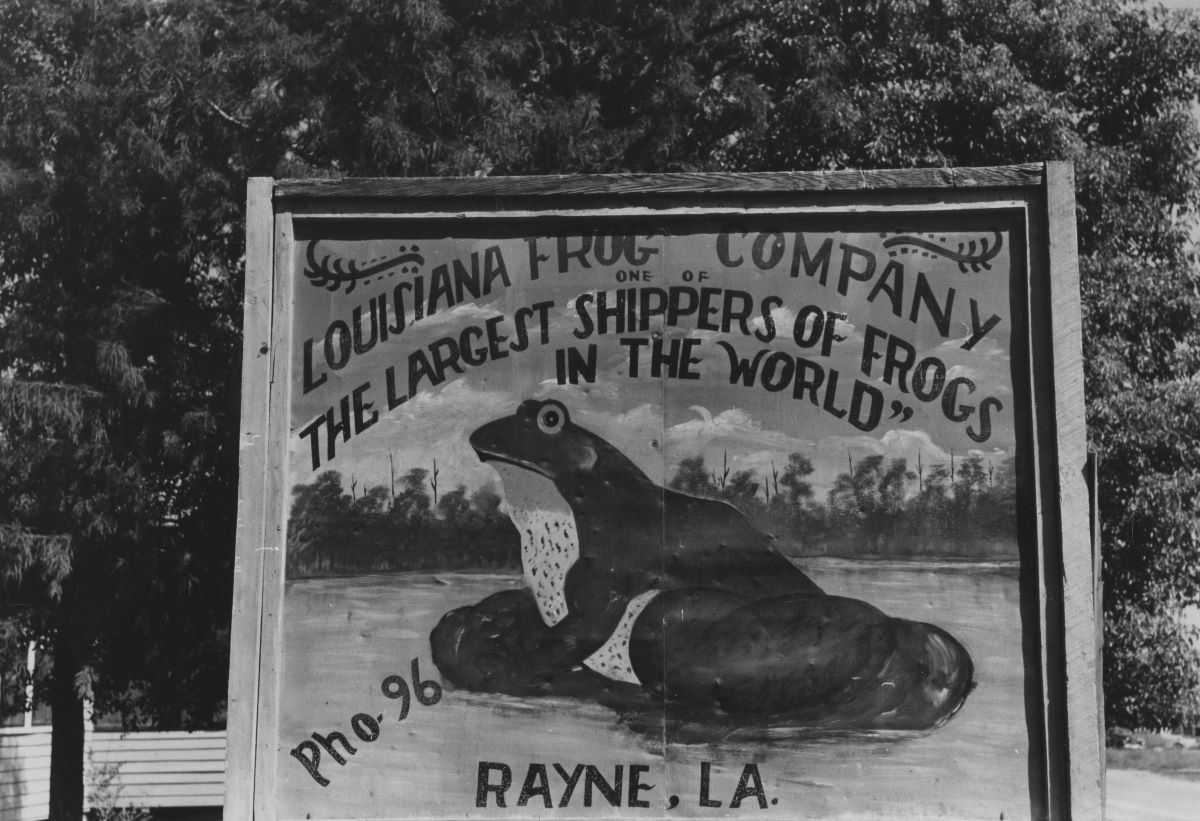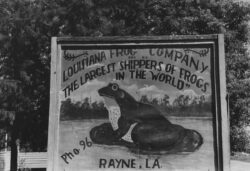Rayne, Frog Capital
Rayne, a city in Acadia Parish, is nicknamed the “Frog Capital of the World” for its history as a former titan in the bullfrog exporting industry.

State Library of Louisiana
Advertisement for Louisiana Frog Company in Rayne, Louisiana. Russell Lee, photographer.
Rayne, a city in Acadia Parish, is nicknamed the “Frog Capital of the World” for its history as a former titan in the bullfrog exporting industry.
Rayne’s association with frogs stems from its incorporation as a prairie town located along a rail line built by the Louisiana Western Railroad in the late nineteenth century. The original depot was known as Rayne Station.
Entrepreneurs migrated to the new community, and within a few years, the Rayne rail depot became a hub of activity. A visiting reporter from the Daily Picayune wrote in 1887 that he “witnessed such bustle and confusion as is only equaled by the French Market of New Orleans on Sunday mornings.” The reporter went on to mention one “very heavy shipper” from twenty-five miles south of Rayne who arrived with a cargo of bullfrogs.
One of the leading frog merchants of the era was Donat Pucheu, a recent French immigrant, who owned a saloon named the Rayne Drop Inn. As a side business Pucheu stocked and sold wild game from the surrounding prairies and waterways of western Acadiana: duck, quail, and bullfrogs—or ouaouaron in Cajun French. A scarce commodity in other parts of the state, frogs would be packed in ice and shipped to New Orleans, where restaurant chefs served their legs, most often sautéed in butter and garlic. In France, by at least the fifteenth century, frogs were commonly eaten by the lower classes. (The common tale that the Catholic Church categorized frogs as fish, thus allowing parishioners to eat them during Lent, is more likely legend than fact.)
In 1899 a second French immigrant family, the Weils, entered the local frog trade. Originally from Paris, Jacques Maurice Weil, with the help of his brothers Edmond and Gontran, managed the mercantile firm of Boudreaux, Leger, and Weil, whose headquarters was directly across Pucheu’s barroom on Polk Street. Weil eventually emerged as Rayne’s premier frog dealer. He built a caged frog pen capable of holding fifteen thousand frogs, expanded the business to offer frog leather goods, and extended their shipping network to Chicago, Los Angeles, and, according to one account, even Paris.
In the early twentieth century, other intrepid entrepreneurs joined the frog trade. The most important of these was the Louisiana Frog Company, which opened in 1931 in nearby Mermentau before moving to Rayne in 1933. The company soon became the largest shipper of frogs in the world, exporting half a million just four years later. Besides frogs destined for the dinner table, Louisiana Frog manufactured canned frog à la sauce piquante, packed frogs for classroom dissection labs, and supplied NASA with two specimens—named Pierre and Tee-Nom—that orbited the earth in 1970. By midcentury Rayne was heralded as the Frog Capital of the World.
Increased competition from the international frog market led Rayne to sponsor the first Frog Festival in 1973. It expanded upon the Frog Derby, a racing event with frogs in jockey uniforms, first held at Crowley’s International Rice Festival in 1946. The Rayne Frog Festival, held each May, features a Frog Derby Queen, frog kissing, frog jumping, costume contests, and opportunities to eat frog legs.
Rayne no longer exports frogs—the Louisiana Frog Company stopped shipping in 1973 and sold its interests three years later—but there are frog statues and murals, the latter of which have led to another moniker, “The City of Murals.”
